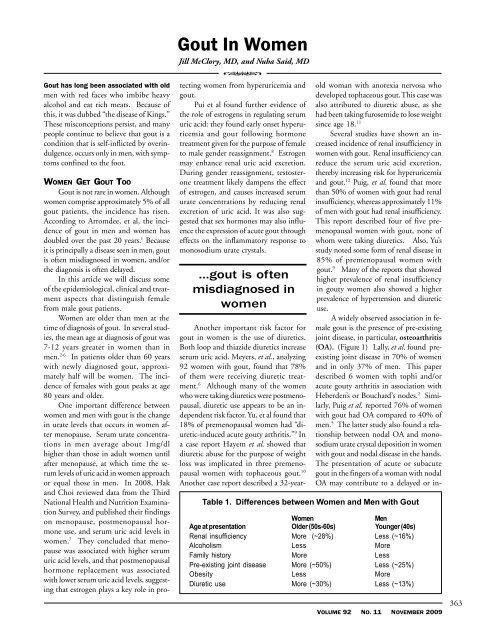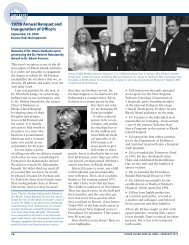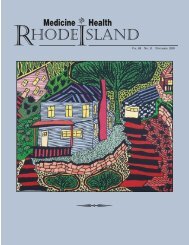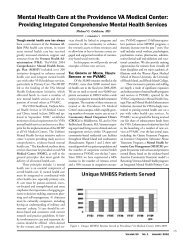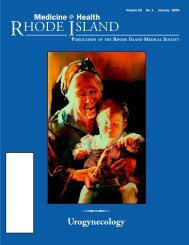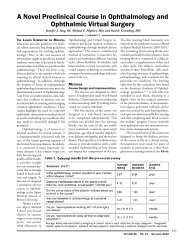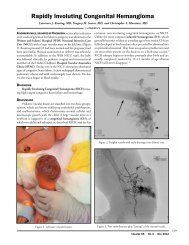Hyperuricemia & Gout - Rhode Island Medical Society
Hyperuricemia & Gout - Rhode Island Medical Society
Hyperuricemia & Gout - Rhode Island Medical Society
Create successful ePaper yourself
Turn your PDF publications into a flip-book with our unique Google optimized e-Paper software.
<strong>Gout</strong> has long been associated with old<br />
men with red faces who imbibe heavy<br />
alcohol and eat rich meats. Because of<br />
this, it was dubbed “the disease of Kings.”<br />
These misconceptions persist, and many<br />
people continue to believe that gout is a<br />
condition that is self-inflicted by overindulgence,<br />
occurs only in men, with symptoms<br />
confined to the foot.<br />
<strong>Gout</strong> In Women<br />
Jill McClory, MD, and Nuha Said, MD<br />
<br />
WOMEN GET GOUT TOO<br />
<strong>Gout</strong> is not rare in women. Although<br />
women comprise approximately 5% of all<br />
gout patients, the incidence has risen.<br />
According to Arromdee, et al, the incidence<br />
of gout in men and women has<br />
doubled over the past 20 years. 1 Because<br />
it is principally a disease seen in men, gout<br />
is often misdiagnosed in women, and/or<br />
the diagnosis is often delayed.<br />
In this article we will discuss some<br />
of the epidemiological, clinical and treatment<br />
aspects that distinguish female<br />
from male gout patients.<br />
Women are older than men at the<br />
time of diagnosis of gout. In several studies,<br />
the mean age at diagnosis of gout was<br />
7-12 years greater in women than in<br />
men. 2-6 In patients older than 60 years<br />
with newly diagnosed gout, approximately<br />
half will be women. The incidence<br />
of females with gout peaks at age<br />
80 years and older.<br />
One important difference between<br />
women and men with gout is the change<br />
in urate levels that occurs in women after<br />
menopause. Serum urate concentrations<br />
in men average about 1mg/dl<br />
higher than those in adult women until<br />
after menopause, at which time the serum<br />
levels of uric acid in women approach<br />
or equal those in men. In 2008, Hak<br />
and Choi reviewed data from the Third<br />
National Health and Nutrition Examination<br />
Survey, and published their findings<br />
on menopause, postmenopausal hormone<br />
use, and serum uric acid levels in<br />
women. 7 They concluded that menopause<br />
was associated with higher serum<br />
uric acid levels, and that postmenopausal<br />
hormone replacement was associated<br />
with lower serum uric acid levels, suggesting<br />
that estrogen plays a key role in protecting<br />
women from hyperuricemia and<br />
gout.<br />
Pui et al found further evidence of<br />
the role of estrogens in regulating serum<br />
uric acid: they found early onset hyperuricemia<br />
and gout following hormone<br />
treatment given for the purpose of female<br />
to male gender reassignment. 8 Estrogen<br />
may enhance renal uric acid excretion.<br />
During gender reassignment, testosterone<br />
treatment likely dampens the effect<br />
of estrogen, and causes increased serum<br />
urate concentrations by reducing renal<br />
excretion of uric acid. It was also suggested<br />
that sex hormones may also influence<br />
the expression of acute gout through<br />
effects on the inflammatory response to<br />
monosodium urate crystals.<br />
…gout is often<br />
misdiagnosed in<br />
women<br />
Another important risk factor for<br />
gout in women is the use of diuretics.<br />
Both loop and thiazide diuretics increase<br />
serum uric acid. Meyers, et al., analyzing<br />
92 women with gout, found that 78%<br />
of them were receiving diuretic treatment.<br />
6 Although many of the women<br />
who were taking diuretics were postmenopausal,<br />
diuretic use appears to be an independent<br />
risk factor. Yu, et al found that<br />
18% of premenopausal women had “diuretic-induced<br />
acute gouty arthritis.” 9 In<br />
a case report Hayem et al. showed that<br />
diuretic abuse for the purpose of weight<br />
loss was implicated in three premenopausal<br />
women with tophaceous gout. 10<br />
Another case report described a 32-yearold<br />
woman with anorexia nervosa who<br />
developed tophaceous gout. This case was<br />
also attributed to diuretic abuse, as she<br />
had been taking furosemide to lose weight<br />
since age 18. 11<br />
Several studies have shown an increased<br />
incidence of renal insufficiency in<br />
women with gout. Renal insufficiency can<br />
reduce the serum uric acid excretion,<br />
thereby increasing risk for hyperuricemia<br />
and gout. 12 Puig, et al. found that more<br />
than 50% of women with gout had renal<br />
insufficiency, whereas approximately 11%<br />
of men with gout had renal insufficiency.<br />
This report described four of five premenopausal<br />
women with gout, none of<br />
whom were taking diuretics. Also, Yu’s<br />
study noted some form of renal disease in<br />
85% of premenopausal women with<br />
gout. 9 Many of the reports that showed<br />
higher prevalence of renal insufficiency<br />
in gouty women also showed a higher<br />
prevalence of hypertension and diuretic<br />
use.<br />
A widely observed association in female<br />
gout is the presence of pre-existing<br />
joint disease, in particular, osteoarthritis<br />
(OA). (Figure 1) Lally, et al. found preexisting<br />
joint disease in 70% of women<br />
and in only 37% of men. This paper<br />
described 6 women with tophi and/or<br />
acute gouty arthritis in association with<br />
Heberden’s or Bouchard’s nodes. 2 Similarly,<br />
Puig et al. reported 76% of women<br />
with gout had OA compared to 40% of<br />
men. 5 The latter study also found a relationship<br />
between nodal OA and monosodium<br />
urate crystal deposition in women<br />
with gout and nodal disease in the hands.<br />
The presentation of acute or subacute<br />
gout in the fingers of a woman with nodal<br />
OA may contribute to a delayed or in-<br />
Table 1. Differences between Women and Men with <strong>Gout</strong><br />
Women<br />
Men<br />
Age at presentation Older (50s-60s) Younger (40s)<br />
Renal insufficiency More (~28%) Less (~16%)<br />
Alcoholism Less More<br />
Family history More Less<br />
Pre-existing joint disease More (~50%) Less (~25%)<br />
Obesity Less More<br />
Diuretic use More (~30%) Less (~13%)<br />
VOLUME 92 NO. 11 NOVEMBER 2009<br />
363


